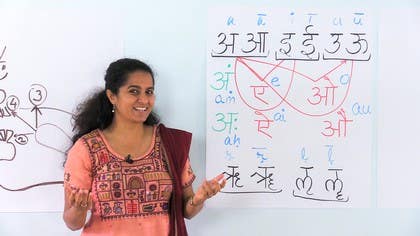Description
About This Video
Transcript
Read Full Transcript
Namaste, Swagatam and welcome back. Very happy to have you on the show again with me. We've been looking at the different letters of the Sanskrit alphabet. Now the source of the Sanskrit alphabet which is sometimes also referred to as the matrika coming from the root ma because it measures out the universe or the vibrations of the universe in the different individual sounds which are also the basic sounds that the human vocal instrument can produce. So the measuring out of those sounds gives us the different letters of the Sanskrit alphabet.
And the source of that particular sound structure is often traced back to the Maheshwarasuthrani of Panini. So the Maheshwarasuthrani, I'll just break up that word for you so you understand it better. So Maheshwara comes from the word Maheshwara which is a name of Shiva. Maheshwara means of Shiva. Sutra means a forism.
It has certain characteristics that defines it as a sutra. But so here we have the Maheshwarasuthrani that was first put out there by Panini who is one of the earliest grammarians of the Sanskrit language. And he codified the entire language using combinations of these sounds that we will see together. And this code of about 3000 of forisms is known as the Ashtadhyayi. It is one of the most authoritative texts on the Sanskrit grammar.
And anything that is composed in the Sanskrit language today, any word that is formed falls back on Panini's Ashtadhyayi as a reference. The story that accompanies the origin of these Maheshwarasuthranis is as follows. Panini who was not a very brilliant student when he was studying at the Gurukula, the Gurukula is the traditional education system of India, was once advised by his teacher, in fact the wife of his teacher told him, my son, if you are finding it very hard they say that if you meditate on Lord Shiva and get his blessings, it will help in the improvement of your knowledge. So Panini then set out to the forest and as he was meditating in that forest on the Lord Shiva, there were many others who were meditating at the same time. They say that there were seven sages meditating in that forest.
And when they all were able to invoke Shiva, the Lord appears and he then plays his drum, which is also known as the Dhammaru. And as he played his drum, the sounds of the drum translated themselves differently to each one of these sages depending on what they were seeking for. So Panini who had come there to learn more about language, to learn more about how words are formed, etc., he heard these sounds as these 14 sutras or 14 aphorisms of the Mahishwara sutrani. So what we can do is, I will read this out to you and you can just close your eyes. Just listen to the sounds of the Mahishwara sutrani.
Ai un rilrik e om ai ouch hai yavarat lan nyamanganam jabhain ghadhadhash jabhagadhadash kappa chattata chattatav kapai shasrasar hal. Is the drum still beating? Now you can open your eyes and follow along with me. Ai un rilrik e om ai ouch hai yavarat lan nyamanganam jabhain ghadhadhash jabhagadhadash Take a deep breath, kappa chattata chattatav kapai shasrasar hal. Would you like to do it once more?
Yeah? We'll do it together and the last time you just close your eyes and listen to it. The Mahishwara sutrani have the power again of recreating a different rhythm within ourselves, energizing the chakras within our being because each of these letters corresponds to a different petal in the different chakras in our system. And therefore just by saying this in this particular order, there is a way of stimulating these different petals in a manner that there is a spontaneous harmony that is created in your body. The sutras or the rhythm of the sutras is in keeping with Shiva's dhammaru or the drum and they say that the drum is significant of time itself, the way time is marked out in creation.
So allowing these sounds to play in your being can be a way of realigning your system to an underlying sound structure or an underlying time frame or a time structure. So say it along with me once and then just close your eyes and listen. I'll just do it a few times maybe. This particular row here has all the different nasal sounds in the Sanskrit alphabet. So though they are different ends, they are pronounced differently.
And here you have to make sure in this particular one, you have to make sure that you get your breath correct. So all these five here have the breath really loud and clear. Start it and then the same sounds almost but without the breath. It's a good exercise. So now close your eyes and then just listen.
I'll do it once for you. Relax and let the sounds resound within your being. Here we go. Enjoy the sounds.
Mother Tongue: The Sound of Sanskrit
Comments
You need to be a subscriber to post a comment.
Please Log In or Create an Account to start your free trial.












